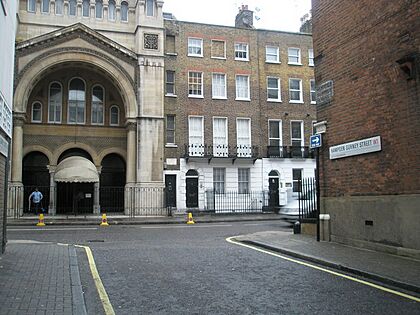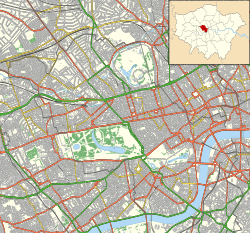West London Synagogue facts for kids
Quick facts for kids West London Synagogue |
|
|---|---|
|
Hebrew: ק"ק שער ציון
|
|

The synagogue, shown from the junction of Hampden Gurney and Upper Berkeley Streets
|
|
| Religion | |
| Affiliation | Reform Judaism |
| Ecclesiastical or organisational status | Synagogue |
| Leadership |
|
| Status | Active |
| Location | |
| Location | 34 Upper Berkeley Street, City of Westminster, London, England W1H 5AU |
| Country | United Kingdom |
| Architecture | |
| Architect(s) |
|
| Architectural type | Synagogue architecture |
| Architectural style | Byzantine Revival |
| Date established | 1840 (as a congregation) |
| Completed |
|
| Construction cost | GB£20,000 |
| Capacity | 1,000 worshipers |
The West London Synagogue, abbreviated WLS, and fully the West London Synagogue of British Jews (Hebrew: ק"ק שער ציון, romanized: Kahal Kadosh Sha'ar Tziyon, lit. 'Holy Congregation Gate of Zion') is a Reform Jewish congregation and synagogue, located near Marble Arch, at 34 Upper Berkeley Street, in the City of Westminster, in Central London, England, in the United Kingdom.
The congregation was established on 15 April 1840. The current synagogue building was dedicated in 1870, and was Grade II listed in 1989. It is one of the oldest synagogues in the United Kingdom and it was the oldest house of prayer affiliated with the Movement for Reform Judaism, before its affiliation lapsed in February 2023.
History
19th century
On 15 April 1840, 24 members of the Mocatta, Goldsmid and other families announced their secession from their respective congregations, the Sephardi Bevis Marks Synagogue and the Ashkenazi Great Synagogue of London, and their intention to form a prayer group for neither "German nor Portuguese" Jews but for "British Jews", which would allow them to worship together. The Mocattas and Goldsmids had been quarrelling with the wardens and complaining over lack of decorum for years. The new prayer group, convening in Burton Street, hired Reverend David Woolf Marks in March 1841. Marks and the congregation adopted a unique, bibliocentric approach often termed "neo-Karaism" by their critics, largely rejecting the authority of the Oral Torah. They abolished the second day of festivals and excised various prayers grounded in rabbinic tradition. It was only after almost a century that the congregation adopted mainstream Reform Judaism.
On 27 January 1842, the West London Synagogue of British Jews was consecrated in its first permanent building, at Burton Street Chapel. By 1848, it had become too crowded for the congregation. A new location was found, in Margaret Street, Cavendish Square, at a cost of £5,000. It was dedicated on 25 January 1849. In 1867, a new location was required again. Eventually, the current synagogue building in Upper Berkeley Street was opened on 22 September 1870. It cost £20,000 and had capacity for 1,000 congregants at the time.
Marks retired in 1895. His successor, Rabbi Morris Joseph, abandoned his predecessor's philosophy, which was never very popular with constituents, and brought West London closer to mainstream Reform by removing from the liturgy its petitions for the restoration of sacrifices in Jerusalem.
20th and 21st centuries
Since the 1920s, men and women have been able to sit together during West London Synagogue services. In 1929, the synagogue appointed Hebrew Union College graduate Rabbi Harold F. Reinhart, who brought it into the World Union for Progressive Judaism. In 1942, West London Synagogue was a founding member of the Associated British Synagogues (now called the Movement for Reform Judaism).
In 1957 Rabbi Reinhart resigned as Senior Minister and, accompanied by 80 former members of West London Synagogue, established the New London Synagogue which, shortly afterwards, was renamed Westminster Synagogue.
He was succeeded by Rabbi Werner van der Zyl, who served as Senior Rabbi from 1958 to 1968. Rabbi Hugo Gryn succeeded van der Zyl in 1968, until his death in 1996. Rabbi Julia Neuberger served as Senior Rabbi from 2011 to 2020.
In February 2020, after a long-running dispute with the Movement for Reform Judaism (MRJ), West London Synagogue suspended its membership of MRJ. In February 2023, the Synagogue's affiliation to MRJ lapsed after a prolonged period of disputed non-payment of fees to the MRJ.
Archives
The synagogue's archives, from 1841 to 1942, are held in the University of Southampton Libraries Special Collections.
Clergy
The following individuals have served as senior rabbi of the congregation:
| Ordinal | Officeholder | Term start | Term end | Time in office | Notes |
|---|---|---|---|---|---|
| 1 | David Woolf Marks | March 1841 | 1893 | 51–52 years | |
| 2 | Morris Joseph | c. 1893 | c. 1930 | 35–36 years | |
| 3 | Harold F. Reinhart | c. 1929 | 1957 | 27–28 years | |
| 4 | Werner van der Zyl | 1958 | 1968 | 9–10 years | |
| 5 | Hugo Gryn | 1968 | 1996 | 27–28 years | |
| 6 | Mark Winer | 1998 | 2010 | 11–12 years | |
| 7 | Julia Neuberger DBE | 2011 | 2020 | 8–9 years | Emerita since 2020 |
| 8 | Helen Freeman | 1 April 2020 | incumbent | 4 years, 49 days | |
| David Mitchell |
Ritual and edifice
Services at West London Synagogue follow the prayer books of the Movement for Reform Judaism, which incorporate material from both Sephardi and Ashkenazi traditions. A choir and organ, located behind a screen to the rear of the bimah, accompany the congregation in all musical parts of the service except for the aleinu and the Kaddish. Men and women sit together during services, and also play equal parts in leading them. Male worshippers are required to wear a kippah; females can wear one if they wish to do so.
The current building, dating from 1870, is located near Marble Arch in London. The main sanctuary was built in the Neo-Byzantine architectural style by Davis & Emmanuel. Its premises, which extend into Seymour Place, also contain offices, a library and various community facilities. The bimah and Torah ark were built in 1869–70 by Davis & Emmanuel. The synagogue's organ, which was renovated in 2007, has 55 stops on four manuals and pedal.
See also
- History of the Jews in England
- List of Jewish communities in the United Kingdom
- List of synagogues in the United Kingdom



